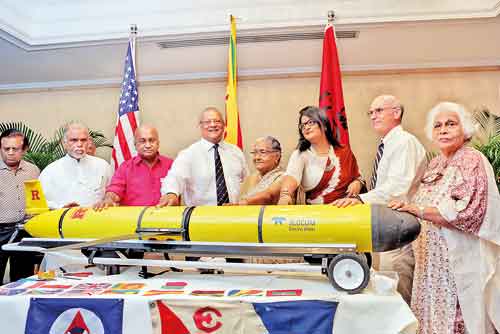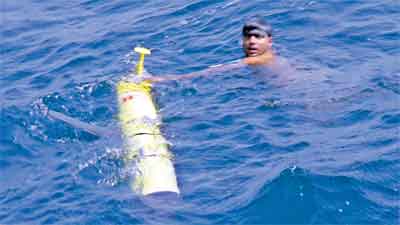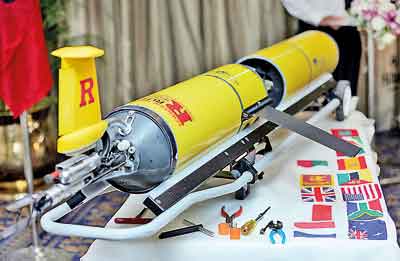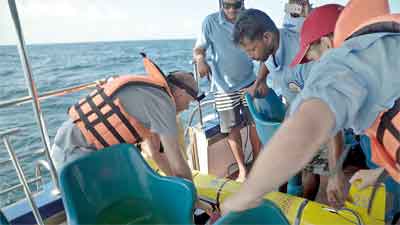So far, so good

Celebrity Challenger – Prof. Charitha Pattiaratchi (fourth from left) and his mother pose for a photo with Prof. Scott Glenn (second from right) and other invitees at the welcoming ceremony. Pix by Sameera Weerasekera
Sleek and elegant, with nary a scratch on its smooth yellow surface, it was the cynosure of all eyes at a simple welcoming ceremony on Monday, far away from where it was ‘recovered’.
The “oohs” and “aahs” of admiration and jostling around to pose for photographs standing by it or with hands on it, were for ‘Challenger’, the unmanned electric ocean glider.
The raison d’etre for the ceremony at the Hilton Hotel in Colombo amidst a distinguished gathering was a first in the world – the longest journey of an unmanned submarine gliding through the ocean – 7,570km so far, to be exact, over 330 days. Challenger’s mission is to gather data and map the mysteries of the Indian Ocean which would help in forecasting the weather.
The most poignant photograph, however, was Prof. Charitha Pattiaratchi and his mother, Chandralatha, looking at the glider in all tenderness. For, Challenger is the ‘baby’ of Prof. Pattiaratchi who is leader of the Australian National Facility for Ocean Gliders and Professor of Coastal Oceanography at the Oceans Institute of the University of Western Australia whose team joined forces with Prof. Scott Glenn from Rutgers University in New Jersey, United States of America and his team to deploy the glider.
This was after it had “revealed” the secrets buried within it in tubings – tiny flags of the countries involved in this major scientific expedition and Letters of Intent – generating the mysterious aura of messages in bottles flung up on the seashore.

Recovering Challenger off Mirissa
Recovery of this remotely-controlled seven-foot mini-submarine, however, was at Mirissa in the south on September 30, braving choppy seas and severe sea-sickness in a whale-watching boat, 40km from the coast, after which it was carefully transported to Colombo by vehicle.
It was very windy and there were more waves than we liked, says Prof. Glenn, commending the Sri Lankan boat crew for being excellent as also the person who got into the waters to recover Challenger by roping it in.
The saga of Challenger is not over, for it was due to be put to sea, once again at Mirissa yesterday for another lap of its outward journey from the western port of Fremantle in Australia on November 4, last year, with the stopover in Mirissa, Sri Lanka and on to South Africa (Reunion Island close to Madagascar) and then back to Australia, circumnavigating the Indian Ocean over a three-year period.

Not any worse for wear after nearly a year at sea - Challenger in its glory
Of the first lap, Prof. Pattiaratchi says that it all depended on the current, “for when I wanted it to go somewhere, it went somewhere else”.
Laughingly he recalls how for almost a year, there would be a “phone hook-up” every Friday, with his wife not being very happy about it. Now, as the Challenger sets off on its next leg, he is bent on changing the Friday to a different day to keep the weekend free for family.
Challenger also has the cleanest world record, smiles Prof. Pattiaratchi, recognized as one of the world’s leading coastal physical oceanographers who is at the forefront of predicting weather events such as storms and storm surges and collaborating in the development and transfer of early-warning systems to countries which lack them, in major efforts to save lives. “No flora or fauna could cling onto it because the ocean’s surface temperature was 300C and at the bottom of the ocean it was 40C which was not very conducive for them.”
Adds Prof. Glenn from Rutgers University’s Center for Ocean Observing Leadership that they have gathered lots of data, transmitted by Challenger every time it surfaced which has enabled them to do ocean forecasting and modelling. Thereafter, the data are stored in the national archives for scientific use in the different countries as well as for students.
 The students have constantly been able to be part of ocean research through the Challenger mission and it is a “big change” for them. Whatever jobs they take up once leaving university, they will forever remember the exciting times of Challenger, he says.
The students have constantly been able to be part of ocean research through the Challenger mission and it is a “big change” for them. Whatever jobs they take up once leaving university, they will forever remember the exciting times of Challenger, he says.
The biggest challenge for Challenger, meanwhile, was when it came across fresh water in the ocean due to the monsoon rains etc, especially in the Bay of Bengal. “The data are fantastic, of course, but the worry was that the valuable glider would get stuck below the surface due to the different density of the freshwater and we would lose it,” he says.
To meet this challenge, for the first time the team had a propeller at the end to give the glider that extra boost when encountering freshwater. “We are so amazed – it worked.” The propeller stayed closed most of the time but when the glider encountered freshwater and needed that extra-little push, it opened out and began spinning, giving that boost, a beaming Prof. Glenn points out.
While Australian High Commissioner Bryce Hutchesson was thrilled over the “ambitious” undertaking of the Challenger mission, American Embassy’s Management Officer Michael Cragun, representing the US Ambassador said it was an exciting day to see the flags emerge from the glider.
It was also exciting to see innovation and an elegant solution through an impressive piece of innovation. It was interesting for science which is allowing for measures to safeguard lives and property, he added.


